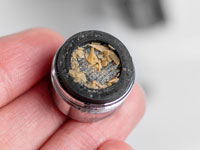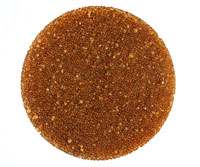In most cases, light-colored particles or residues are caused by naturally occurring minerals in our water, like calcium and magnesium. The presence of these minerals is why our city’s water is considered hard water. Drinking hardness minerals is not a health concern and can be considered beneficial since our bodies use these essential nutrients to function. But they can be a nuisance when they cause build-up in plumbing and on fixtures and appliances. Hardwater minerals can also become visible in ice, especially after the ice melts.
 Light-colored particles or residues are usually caused by naturally occurring minerals in our water
Light-colored particles or residues are usually caused by naturally occurring minerals in our water
Plumbing work, pipe vibrations, or adding a water softener can cause mineral scale inside the pipes to become loose and enter the water or get trapped inside faucet aerators. Sometimes, these particles will have a mix of colors that came from the metals in the plumbing.
Try this first
-
If you fill a clear glass with water and let it sit for a few minutes, does the water start to clear up starting from the bottom of the glass?
If it does, the white particles are actually tiny bubbles of air. See the section on cloudy water for more information.
-
Place the particles in undiluted vinegar.
If the particles bubble or dissolve after a few hours, they are mineral deposits that come from hard water. If they do not dissolve, they may be pieces of plastic from your water heater’s dip tube requiring repair or resin beads from your softener requiring maintenance.
 Water softener resin beads
Water softener resin beads
Recommendations
Mineral build-up on appliances and surfaces – Hard water causes calcium to build up in water heaters, dishwashers, coffeemakers, washing machines, and humidifiers. Follow the manufacturer’s instructions on how to maintain your appliances for hard water. Flush your water heater annually to remove sediment build-up. Vinegar and a non-scratch scouring pad works well for cleaning humidifiers and many other surfaces. Let the vinegar sit on the build-up for a few minutes before scrubbing and rinse thoroughly. Because vinegar can damage certain materials, check the appliance manufacturer’s instructions or test the vinegar in an inconspicuous spot before use.
Clogged faucets – If possible, remove the aerator from the tip of the faucet. This can be placed in vinegar for a several minutes and then scrubbed to remove hardwater build-up. Shower heads can also be cleaned with vinegar or other safe de-scaling products.
White film or spots on dishes – Towel-dry dishes to prevent water from evaporating and leaving spots on dishes. If dishes coming out of the dishwasher are cloudy, use detergent made for hard water and add rinse-aid or another conditioner. Follow your dishwasher’s manual for instructions for mineral removal. Typically, this involves adding vinegar or a specially-designed cleaner to an empty dishwasher and running a cycle.
If the cloudiness on your glassware does not clear up after cleaning with vinegar, it may be etched. Etching is caused by tiny scratches in the glass and is permanent. It is often caused by a combination of the wrong detergent or too much detergent, soft water, high temperatures, and dishes being rinsed too thoroughly before washing. Homeowners should consult their dishwasher owner’s manual or visit the manufacturer’s website for instructions on preventing glass etching.
See our Annual Drinking Water Quality Report for the most recent hardness results.
If you have concerns or questions regarding particles in your water, please call Lincoln Water System at 402-441-7571 option 2.